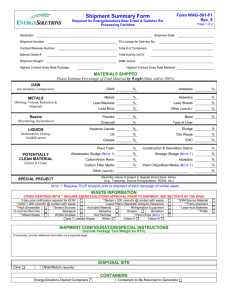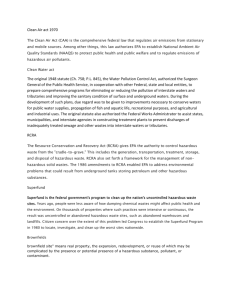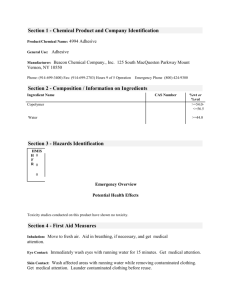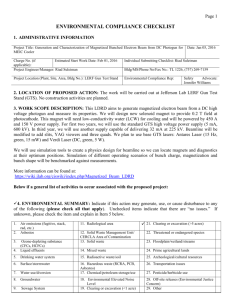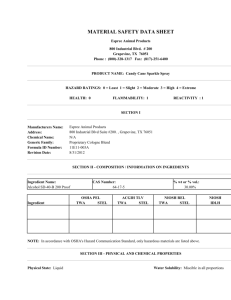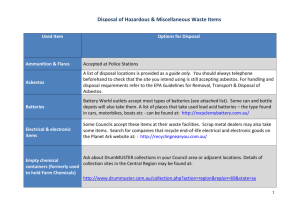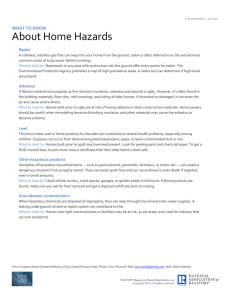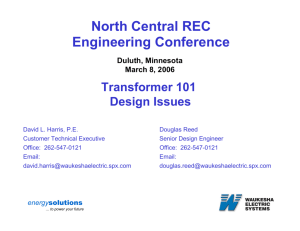Bulk Waste Assay Program Profile (Rev.4)
advertisement
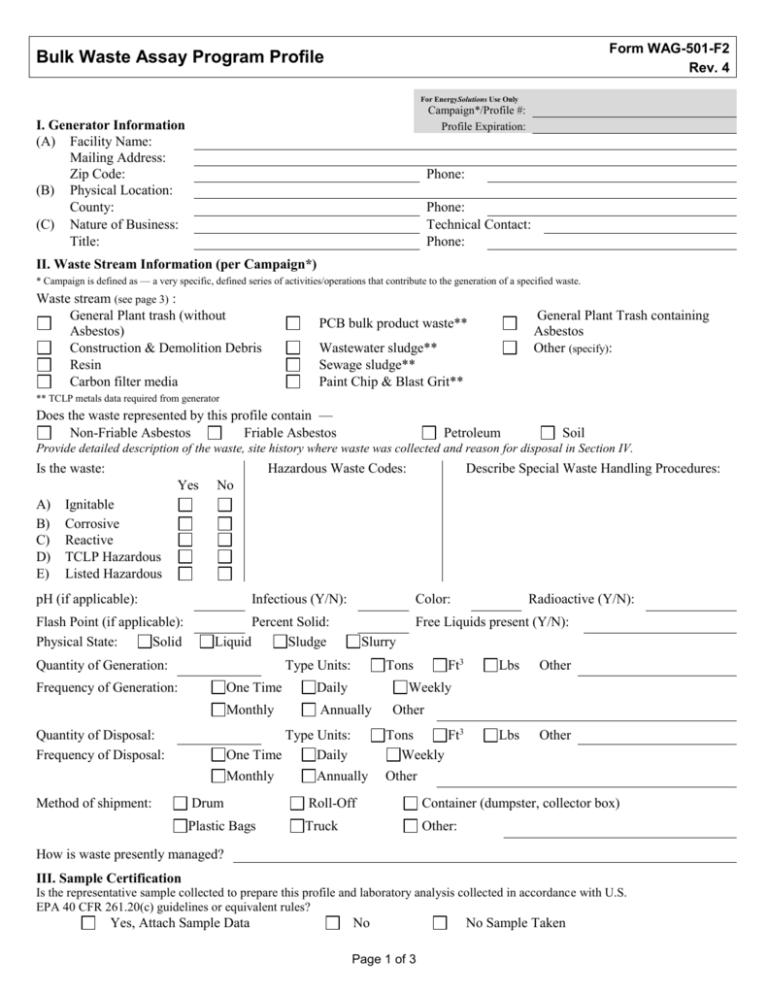
Form WAG-501-F2 Rev. 4 Bulk Waste Assay Program Profile For EnergySolutions Use Only Campaign*/Profile #: Profile Expiration: I. Generator Information (A) Facility Name: Mailing Address: Zip Code: (B) Physical Location: County: (C) Nature of Business: Title: Phone: Phone: Technical Contact: Phone: II. Waste Stream Information (per Campaign*) * Campaign is defined as — a very specific, defined series of activities/operations that contribute to the generation of a specified waste. Waste stream (see page 3) : General Plant trash (without Asbestos) Construction & Demolition Debris Resin Carbon filter media General Plant Trash containing Asbestos Other (specify): PCB bulk product waste** Wastewater sludge** Sewage sludge** Paint Chip & Blast Grit** ** TCLP metals data required from generator Does the waste represented by this profile contain — Non-Friable Asbestos Friable Asbestos Petroleum Soil Provide detailed description of the waste, site history where waste was collected and reason for disposal in Section IV. Is the waste: Hazardous Waste Codes: Yes A) B) C) D) E) Describe Special Waste Handling Procedures: No Ignitable Corrosive Reactive TCLP Hazardous Listed Hazardous pH (if applicable): Flash Point (if applicable): Physical State: Solid Infectious (Y/N): Percent Solid: Liquid Sludge Quantity of Generation: Quantity of Disposal: Frequency of Disposal: Radioactive (Y/N): Free Liquids present (Y/N): Slurry Type Units: Frequency of Generation: Method of shipment: Color: Ft3 Tons One Time Daily Monthly Annually Lbs Other Lbs Other Weekly Other Type Units: One Time Daily Tons Ft3 Weekly Monthly Other Annually Drum Roll-Off Container (dumpster, collector box) Plastic Bags Truck Other: How is waste presently managed? III. Sample Certification Is the representative sample collected to prepare this profile and laboratory analysis collected in accordance with U.S. EPA 40 CFR 261.20(c) guidelines or equivalent rules? Yes, Attach Sample Data No Page 1 of 3 No Sample Taken Form WAG-501-F2 Rev. 4 Bulk Waste Assay Program Profile IV. Include a narrative and a flow diagram of the process that generates the waste. Your explanation must describe the POTENTIAL contaminants, hazardous constituents, petroleum and physical characteristics of the waste which should justify your scope of constituents. (attach additional pages if necessary): This waste does not contain RCRA hazardous or petroleum constituents. Does this waste contain RCRA hazardous constituents? Yes No Does this waste contain petroleum constituents? Yes No Is this a regulated Radioactive Waste as defined by federal and/or state regulations? Yes No Is this a regulated RCRA waste per 40 CFR 262.11? Does this waste or generating process contain the following Pesticides and/or Herbicides: Chlordane, Endrin, Heptachlor (and its epoxides), Lindane, Methoxychlor, Toxaphene, 2,4-D, or 2,4,5-TP Silvex as defined in 40 CFR 261.33? Does this waste or generating process cause it to exceed OSHA exposure limits from high levels of Hydrogen Sulfide or Hydrogen Cyanide as defined in 40 CFR 261.23? Does this waste contain listed hazardous wastes defined in 40 CFR 261.31, 261.32, 261.33, including RCRA F-Listed Solvents? Yes No Yes No Yes No Yes No Does this waste contain 2,3,7,8-Tetrachlorodibenzodioxin (2,3,7,8-TCCD), or any other dioxin as defined in 40 CFR 261.31? Yes No Is this waste generated at a Federal Superfund Cleanup Site? Yes No Does this waste contain Polychlorinated Biphenyls (PCBs) as defined in 40 CFR Part 761? Yes No Is this a regulated Toxic Material as defined by federal and/or state regulations? Yes No Is this a regulated Medical or Infectious Waste as defined by federal and/or state regulations? Yes No VI. Generator Certification I hereby certify that the information contained herein is a true and accurate description of the waste material being offered for disposal and that by utilizing this profile, neither myself nor any other employee of the company will deliver for disposal or attempt to deliver for disposal any waste that this facility is prohibited from accepting by law. I understand that any waste processed via this profile for BWAP is a candidate for municipal waste landfill disposal. All changes that occur in the character of the waste will be identified by the company and disclosed to this EnergySolutions facility prior to providing the waste to EnergySolutions. Our company hereby agrees to fully indemnify EnergySolutions against any damages resulting from this certification being inaccurate or untrue. I further certify that the company has not altered the form or content of this profile sheet as provided by EnergySolutions. I certify that all waste to be shipped to EnergySolutions as part of this campaign for eventual disposal at BFI-Carters Valley Landfill (Reg. Number SNL #37-104-0185 EXT.) is not a hazardous waste as defined by 40 CFR Part 261 or TN Rule 1200-1-11-.02. Check if additional information is attached. Indicate the number of pages attached. Authorized Representative Name and Title (printed) Company Name Authorized Representative Signature Date VII. FOR EnergySolutions USE ONLY EnergySolutions Waste Decision Approved under existing profile: Approved under new profile: Rejected Conditions: Name Title Signature Date Page 2 of 3 Form WAG-501-F2 Rev. 4 Bulk Waste Assay Program Profile WASTE STREAM DESCRIPTIONS The following provides a description of currently approved Waste Streams. If you have waste that does not meet the following descriptions, please contact your Account Executive for assistance and evaluation for acceptance. A. General Plant Trash (without Asbestos) Plant Trash may include materials in varying quantities such as paper, plastic, wood, glass, cardboard, cloth, rubber, as well as incidental amounts of metal or building materials. RCRA empty containers are also included under the Plant Trash. General Plant Trash cannot contain any asbestos (friable or non-friable). B. Construction and Demolition Debris Construction and Demolition Debris is earthen, paving, or structural materials generated during construction or demolition activities. The waste stream may include soil, dirt, sand, clay, or earthen substrate (including normally occurring rock/stone and plant material); paving materials such as concrete, asphalt, and underlayment (including embedded reinforcing bar and wire); cinder block, brick, and poured concrete (including embedded reinforcing bar and wire); roofing materials; non-friable asbestos; and general rubble associated with construction and demolition activities, such as wood, paper, plastic, metal, and rock/stone. C. Wastewater Sludge Wastewater Sludge is sludge material from building drains or sumps commercial nuclear power plants. The material consists of dirt, debris and sediments that have accumulated in low areas of drains or sumps of buildings, in addition to material collected from the downstream settling ponds. The effluents originate from plant cooling and heating equipment leaks and may also include some storm water. The effluent is collected in sumps, ponds, and other low areas of nuclear plants, where the settling sludges are periodically pumped, vacuumed or otherwise removed for disposal. Approved absorbents, such as polymers or corncob, may be added as necessary by EnergySolutions to ensure no freestanding liquid is present. TCLP analysis must be submitted to EnergySolutions on each campaign of waste to ensure that heavy metals do not exist in quantities exceeding RCRA hazardous waste limits. D. Resin Resin is mixed anion and cation bead resin used for water purification in nuclear facilities. E. Carbon Filter Media Carbon Filter Medial is carbon (charcoal) used in plant air purification systems. This waste stream is dry. This waste stream does not include charcoal from pollution control equipment. F. Sewage Sludge Sewage Sludge is treated sanitary sewage waste (human waste only) generated outside the radiologically controlled area and accumulated to prevent off-site discharge. The waste should generally contain no freestanding liquids on receipt at EnergySolutions. TCLP analysis must be submitted to EnergySolutions on each campaign of waste to ensure that heavy metals do not exist in quantities exceeding RCRA hazardous waste limits. G. Paint Chips & Blast Grit Paint chips are dried flecks of previously applied paint, or overspray, or blasting. This waste stream may also contain blasting grit. TCLP analysis is performed on each campaign of waste to ensure that heavy metals do not exist in quantities exceeding RCRA hazardous waste limits. H. General Plant Trash containing Asbestos Plant Trash with Asbestos may include materials in varying quantities such as paper, plastic, wood, glass, cardboard, cloth, rubber, as well as incidental amounts of metal or building materials and RCRA empty containers contaminated with asbestos (friable or non-friable). I. PCB Bulk Product Waste Waste consists of assorted metal piping and equipment with incidental quantities of concrete, glass and plastic that may include paints or coatings manufactured with PCBs. Page 3 of 3

